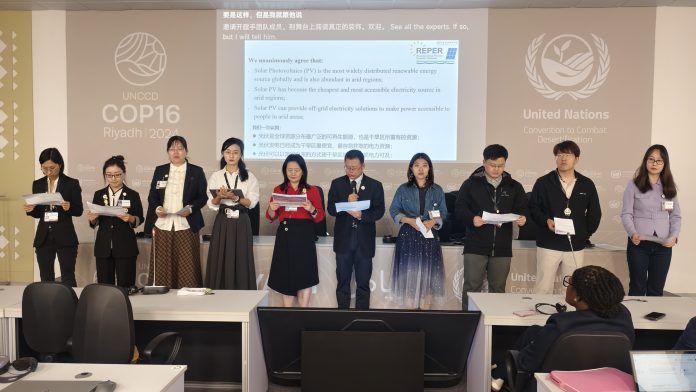December 9, 2024
Riyadh, Saudi Arabia
On December 9, 2024, the 16th Conference of the Parties (COP16) of the United Nations Convention to Combat Desertification (UNCCD) was held in Riyadh, Saudi Arabia. The School of Social Sciences of Tsinghua University, China Renewable Energy Engineering Institute jointly organized the side event titled “Solar Empowers Land and People.” After discussions with participants, the Solar Empowers Land and People Action Plan was collectively released.
We unanimously agree that:
Solar Photovoltaics (PV) is the most widely distributed renewable energy source globally and is also abundant in arid regions;
Solar PV has become the cheapest and most accessible electricity source in arid regions;
Solar PV can provide off-grid electricity solutions to make power accessible to people in arid areas;
Solar PV can directly benefit the people in desert areas in a distributed form, contributing to a just energy transition;
In the pursuit of the SDGs (Sustainable Development Goals) by 2030, Solar PV not only contributes to achieving SDG 7 (affordable and clean energy for all) but also has extensive synergistic effects with multiple SDGs.
We propose the following action directions:
1.Electrification of Daily Life in Arid Regions via Off-Grid PV
The minimum goal is to provide each person with a Solar PV lamp, each household with 1kW of Solar PV, an electric tricycle, and a mobile storage device. The higher goal is to achieve full household electrification using Solar PV and mobile storage.
2.Electrification of Production Activities in Arid Regions via Off-Grid PV
This includes promoting off-grid solar water pumps, sewage treatment systems, condensate water machines, electric tools, small agricultural machinery, and off-grid agricultural equipment (such as shellers, grinders, etc.) in areas without access to the grid.
3.Integration of PV and Grid-Connected Energy Storage
For agricultural production, this integration will help achieve the electrification of irrigation and production processes, enabling the synergistic growth of “water-energy-food” systems. In populated areas, this can contribute to the creation of microgrids powered by 100% renewable energy, covering villages, towns, and even cities.
4.Land Leasing for Solar Power Generation in Grid-Connected Areas
In regions with access to the electricity grid, local people in arid areas can lease land to PV power companies and share in the revenues from solar generation. For grid-connected household solar, solar power generation can become a commodity, with income generated from selling electricity to grid companies, providing a new source of income for local people.
5.Eco-Friendly Design of Grid-Connected Solar Stations
Solar power stations in arid areas must adopt eco-friendly designs, with comprehensive management systems for design, construction, and operation, minimizing the negative impacts on soil, vegetation, and biodiversity, and maximizing ecological benefits.
6.Land Use Integration for Solar Station Development
Solar power stations in arid areas can adopt land integration models such as “Agri-PV,” “Aquaculture-PV,” “Pastoral-PV,” and “Livestock-PV,” ensuring that, while generating electricity, land can also produce agricultural outputs, thereby increasing agricultural income for local communities.
7.Economic Development through PV Base Construction
Arid regions with vast land resources can benefit from the investment stimulation and low-cost green electricity advantages brought by PV base construction. This will help cultivate a new green industrial system, promote local employment, and create zero-carbon industrial parks, leading to comprehensive economic and social upgrading.
Actions to be Taken by Signatories of the “Solar Empowers Land and People” Initiative
Signatories of this initiative will actively engage in the following actions:
1.As Enterprises: Actively develop and promote PV products suitable for arid regions, and participate in the construction of PV power stations and the alignment of PV projects with SDG goals.
2.As Research Institute or Non-profit Organizations: Support the promotion of PV products in arid areas through research, public education, capacity building, consulting services, and more.
3.PV Demonstration Projects: Rely on or cooperate with relevant institutions to implement solar PV demonstration projects and carry out knowledge dissemination activities.
4.Establishing Flagship Projects: Actively participate in creating “Solar empowers Land and People” flagship projects, such as developing “energy-water-soil-plant” integrated zero-carbon systems in nature reserves or ecological demonstration areas, and building zero-carbon villages with zero-carbon electricity, heat, transportation, and cooking in rural areas.
The action plan adopts the “Solar Panda” as its mascot.
The REPER Cooperation Platform plans to summarize and showcase the exploration and achievements of signatories during the two years of this initiative at the UNCCD COP17 scheduled to be held in Ulaanbaatar, Mongolia, in 2026.






